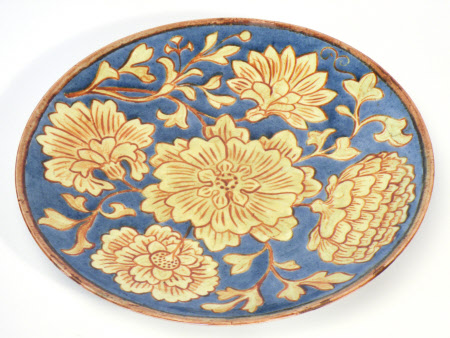Plate
Hugh Thackeray Turner (1853-1937)
Category
Ceramics
Date
1883
Materials
Porcelain
Measurements
25 mm (H)235 mm (Diameter)
Place of origin
Godalming
Order this imageCollection
Standen House and Garden, West Sussex
NT 1213677
Summary
Plate, porcelain, probably Josiah Wedgwood & Co Ltd, ca 1883; decorated under the glaze by Hugh Thackeray Turner in December 1883 with an overall design of yellow flowers and scrolling leaves lined in brown, against a blue ground, a band of brown enamel at the rim, the underside with Turner's monogram and date, the walls decorated with a repeating pattern of stylised flowers with four petals and scrolling stems and leaves.
Full description
This plate is an early example of amateur decoration of porcelain by the architect, Hugh Thackeray Turner. It was made in December 1883, one year after he started ‘china painting’, which he continued to practice for over fifty years. Turner gave each of his plates a number in the order in which they were made – this plate is number 44. Turner joined the office of architect, George Gilbert Scott, in 1874 - perhaps the most influential architectural practice of its time. In 1883, Turner became secretary for The Society for the Protection of Ancient Buildings (SPAB), inspecting and reporting on buildings at risk and advocating for their preservation. He remained at SPAB for 28 years while continuing to design buildings, including his own home at Godalming, Surrey. He was also a gifted musician and amateur ceramic painter. Writing in The Art Journal in 1895, Fred Miller described a conversation with Hugh Thackeray Turner about his ceramic decoration: ‘Mr Thackeray Turner told me that he took up china-painting in 1882, when he started in practice as an architect, as an exercise in designing. He got a firm in Burslem to supply him with bisque (unglazed china), and when painted he got them to glaze and fire for him. Mr Turner at first tried French colours, but gave them up for the Staffordshire trade colours…while it was easy to get work painted in enamels on the glaze fired in London, it was difficult without sending to the potteries to get ware glazed and fired, and amateurs, therefore, wisely confined their chief attention to overglaze work.’ This plate is marked, probably for Spode, a factory in Stoke on Trent, who presumably supplied and might have fired it for him. During the early years of his making, Turner is also known to have worked with a potter, Charles Ford, who made, glazed and fired pieces for him. Turner also used blanks (undecorated pieces) made by Wedgwood. Turner exhibited his works at the annual shows of the Arts & Crafts Exhibition Society, attracting positive critical attention. A 1911 article in The Art Journal, for example, described his work as ‘charming in design and good in craftsmanship, they show a delightful sense of pleasure in the execution of even the smallest details’. As well as exhibiting, Turner displayed pieces at his home, Westbrook, and gave many away as presents but he did not sell his work. This interest ran in his family as Turner’s daughter, Marjorie and brother, Laurence also exhibited ceramics they had decorated. Marjorie gave an example of her father’s work to the Victoria and Albert Museum (ref. CIRC.137-1953).
Marks and inscriptions
Underside of base: 1883 / UNDER GLAZE / No. 44 / DEC / T [artist's monogram] Underside of base: WEDGWOOD [possibly, double impressed and partially transposed] Underside of base: DAN KLEIN LTD [with address, dealer's label, printed in black on paper label]
Makers and roles
Hugh Thackeray Turner (1853-1937), decorator probably Wedgwood, manufacturer
References
art journal. 1849-1912., Fred Miller, ‘Art Workers at Home. Potters and Painters’, The Art Journal, volume 57 (1895), pp. 311-314.
